- Home
- Peter Ackroyd
Venice: Pure City
Venice: Pure City Read online
Venice: Pure City
Peter Ackroyd
With Venice: Pure City, Peter Ackroyd is at his most magical and magisterial, presenting a glittering, evocative, fascinating, story-filled portrait of the ultimate city.
“Ackroyd provides a history of and meditation on the actual and imaginary Venice in a volume as opulent and paradoxical as the city itself. . . . How Ackroyd deftly catalogues the overabundance of the city’s real and literary tropes and touchstones is itself a kind of tribute to La Serenissima, as Venice is called, and his seductive voice is elegant and elegiac. The resulting book is, like Venice, something rich, labyrinthine and unique that makes itself and its subject both new and necessary.” —Publishers Weekly
The Venetians’ language and way of thinking set them aside from the rest of Italy. They are an island people, linked to the sea and to the tides rather than the land. This lat¬est work from the incomparable Peter Ackroyd, like a magic gondola, transports its readers to that sensual and surprising city.
His account embraces facts and romance, conjuring up the atmosphere of the canals, bridges, and sunlit squares, the churches and the markets, the festivals and the flowers. He leads us through the history of the city, from the first refugees arriving in the mists of the lagoon in the fourth century to the rise of a great mercantile state and its trading empire, the wars against Napoleon, and the tourist invasions of today. Everything is here: the merchants on the Rialto and the Jews in the ghetto; the glassblowers of Murano; the carnival masks and the sad colonies of lepers; the artists—Bellini, Titian, Tintoretto, Tiepolo. And the ever-present undertone of Venice’s shadowy corners and dead ends, of prisons and punishment, wars and sieges, scandals and seductions.
Ackroyd’s Venice: Pure City is a study of Venice much in the vein of his lauded London: The Biography. Like London, Venice is a fluid, writerly exploration organized around a number of themes. History and context are provided in each chapter, but Ackroyd’s portrait of Venice is a particularly novelistic one, both beautiful and rapturous. We could have no better guide—reading Venice: Pure City is, in itself, a glorious journey to the ultimate city.
Peter Ackroyd
Venice: Pure City
Acknowledgements
I would like to thank my two research assistants, Thomas Wright and Murrough O’Brien, for their invaluable work on this project. I would also like to extend my thanks to my editor, Jenny Uglow, and my copy-editor, Jenny Overton.
List of Illustrations
Section One
i1.1 Cristoforo Sabbadino, Map of Venice, c.1557. Archivio di stato, Venice/Cameraphoto Arte Venezia/Bridgeman
i1.2 Perspective plan of Venice (detail). Musée du Louvre, Paris/Cameraphoto/Bridgeman
i1.3 The mosaics in Saint Mark’s cathedral, late 14c. Alinari/Rex Features
i1.4 The Madonna, cathedral of Santa Maria Assunta, Torcello, early 13c. akg-images/Cameraphoto
i1.5 The Flood, mosaic in the narthex, western portico, of Saint Mark’s cathedral, 13c. akg-images/Erich Lessing
i1.6 Tintoretto (Jacopo Robusti), The Stealing of the Body of Saint Mark, 1562–66. Galleria dell’Accademia/Cameraphoto/Bridgeman
i1.7 The Lion of Saint Mark, 15c., Museo Correr/Bridgeman
i1.8 Monks praying to Saint Theodore, from a Mariegola, 1350. Museo Correr/Bridgeman
i1.9 Simon Marsden, The columns of Saint Mark and Saint Theodore, Piazzeta San Marco. The Marsden Archive, UK/Bridgeman
i1.10 Gentile Bellini, Procession on the Piazza S. Marco, 1496. Galleria dell’Accademia/akg-images/Erich Lessing
i1.11 Piazza S. Marco, c.1880–90. Roger-Viollet/Rex Features
i1.12 Gentile Bellini, The Miracle of the Cross on San Lorenzo Bridge, 1500. Galleria dell’Accademia/Bridgeman
i1.13 Francesco Guardi, The Departure of the Bucintoro towards the Lido on Ascension Day (detail), 1766–70, Musée du Louvre/Giraudon/Bridgeman
i1.14 Vittore Carpaccio, The patriarch of Grado heals a possessed man on the Rialto Bridge (detail), 1494 Galleria dell’Accademia/akg-images/Cameraphoto
Section Two
i2.1 Paolo Veronese, The Battle of Lepanto, 1571. Galleria dell’Accademia, Venice/akg-images
i2.2 Plan of the Arsenal. Museo Correr, Venice/Bridgeman
i2.3 Franceso Segala, a Venetian warship, on the Mausoleum of Girolamo Michiel, c. 1558–59. Basilica of Sant’Antonio, Padua/Bridgeman
i2.4 Sign for the Marangoni family of shipbuilders, 1517. Museo Correr/Alinari/Bridgeman
i2.5 Jan van Grevenbroeck, Dredging a Canal, 18c. Museo Correr/Giraudon/Bridgeman
i2.6 Jan van Grevenbroeck, An Oar-Maker from the Arsenal, 18c. Museo Storico Navale, Venice/Bridgeman
i2.7 Jan van Grevenbroeck, A Venetian Doctor during the Plague, 18c. Museo Correr/Bridgeman
i2.8 Jan van Grevenbroeck, Venetian Bellmaker’s Shop, 18c. Museo Correr/Bridgeman
i2.9 Venetian glass in the Pauly showrooms, Milan, 1910. Alinari/Rex Features
i2.10 Lace workers on Burano, 19c. Collezione Naya-Bohm, Venice/Bridgeman
i2.11 Ferdinando Ongania, A Venetian Courtyard, c. 1880. Museo di Storia della Fotografia Fratelli Alinari, Florence/Bridgeman
i2.12 A funeral gondola, 1880–1920. Collezione Naya-Bohm, Venice/Bridgeman
i2.13 Giovanni Pividor, The railway bridge across the lagoon, from Views of Principal Monuments in Venice, 1850. Bridgeman
i2.14 The remains of the Campanile, La Domenica del Corriere, 27 July 1902. Cameraphoto Arte Venezia Corriere/Bridgeman
i2.15 “Windows of the Early Gothic Palaces,” from John Ruskin, The Stones of Venice, 1851–3
Section Three
i3.1 Giovanni Bellini, Leonardo Loredan, Doge of Venice, c.1501. National Gallery, London/Bridgeman
i3.2 Joseph Heintz, Audience with the Doge in the College of the Ducal Palace, early 17c. Museo Correr/Bridgeman
i3.3 Pietro Uberti, Portrait of three lawyers, Orazio Bembo, Orazio Angarano and Melchior Gabriel, 1730. Palazzo Ducale/Cameraphoto/Bridgeman
i3.4 Jacobello del Fiore, Justice and the Archangels, 1421. Galleria dell’Accademia/Cameraphoto/Bridgeman
i3.5 The lion’s mouth. Palazzo Ducale/Bridgeman
i3.6 The Pozzi prison, from Vedute delle Prigioni, 18c. Museo Correr/Bridgeman
i3.7 Vittore Carpaccio, Dream of Saint Ursula, 1495, Galleria dell’Accademia/Cameraphoto/Bridgeman
i3.8 Pietro Longhi, The Tailor, 1742–3. Galleria dell’Accademia/Cameraphoto/Bridgeman
i3.9 Pietro Longhi, The Geography Lesson, c.1750–2. Galleria Querini-Stampalia/Bridgeman
i3.10 Pietro Longhi, The Perfume Seller, c.1750. Ca’Rezzonico, Museo del Settecento/Alinari/Bridgeman
i3.11 Madonna of Mercy, 16c. Museo Correr/Alinari/Bridgeman
i3.12 Paolo Veneziano, Madonna and Child Enthroned with Two Devout People, 14c. Galleria dell’Accademia/Cameraphoto/Bridgeman
i3.13 Giovanni Battista Cima da Conegliano, The Coronation of the Virgin, late 15c. Santi Giovanni e Paolo, Venice/Cameraphoto/Bridgeman
i3.14 Giorgione (Giorgio da Castelfranco), The Tempest, c.1506–8. Galleria dell’Accademia/Cameraphoto/Bridgeman
i3.15 Giovanni Bellini, Young Woman at Her Toilet, 1515. Kunsthistorisches Museum, Vienna/akg-images/Erich Lessing
i3.16 Titian (Tizian Vecellio), Venus of Urbino (detail), before 1538. Galleria degli Uffizi, Florence/Bridgeman
Section Four
i4.1 Paolo Veronese, The Marriage Feast at Cana (detail), c. 1562. Musée du Louvre/Giraudon/Bridgeman
i4.2 Gabriele Bella, Concert by the girls of the hospital music societies in the Procuratie, Venice, 18c. Galleria Querini-Stampalia/Bridgeman
i4.3 Francesco Guardi, The Parlour of the San Zaccaria Convent, 18c. Ca’Rezzonic
o, Museo del Settecento, Venice/Bridgeman
i4.4 Pietro Bianchi, Cross-section of a theatre on the Grand Canal, 1787
i4.5 Alessandro Longhi, Carlo Goldoni, 18c. Casa Goldoni, Venice/Bridgeman
i4.6 Jan van Grevenbroeck, Venetian Noblemen in a Café, 18c. Museo Correr/Bridgeman
i4.7 Giandomenico Tiepolo, Pulcinella with Acrobats, fresco 1793. Ca’Rezzonico, Museo del Settecento/Alinari/Bridgeman
i4.8 Francesco Guardi, Three Masked Figures in Carnival Costume, c.1765. Museo Correr/Bridgeman
i4.9 Canaletto (Giovanni Antonio Canal), Regatta on the Grand Canal, 1735–40. Bowes Museum, Barnard Castle, County Durham/Bridgeman
i4.10 V. Ponga, Masked Ball in Saint Mark’s Square, 19c. Caffe Quadri, Venice/Bridgeman
i4.11 Gabriele Bella, Battle with Sticks on the Ponte Santa Fosca, 18c. Galleria Querini-Stampalia/Giraudon/Bridgeman
i4.12 Gabriele Bella, Game of Bowls in the Campo dei Gesuiti, 18c. Galleria Querini-Stampalia/Bridgeman
i4.13 Sir Claude Francis Barry Bart., RBA, The Bridge of Sighs, etching, c.1930. Private collection/Bridgeman/www.sirfrancisbarry.com
i4.14 Cover of René Jeanne, Casanova, 1927, with photographs from Andre Volkoff 1926 film. Private collection/Archives Charmet/Bridgeman
i4.15 Hugo d’Alesi, travel poster for the Chemin de fer de l’Est, Paris to Venice, 19c. Stapleton Collection/Bridgeman
Part Titles. The vignettes, engraved by Dionisio Moretti, are taken from Antonio Quadri, Il Canal Grande di Venezia (1831)
I City from the Sea
1
Origins
They voyaged into the remote and secluded waters. They came in flat-bottomed boats, moving over the shallows. They were exiles, far from their own cities or farms, fleeing from the marauding tribes of the North and the East. And they had come to this wild place, a wide and flat lagoon in which fresh water from the rivers on the mainland and salt water from the Adriatic mingled. At low tide there were mud-flats all around, cut through with streams and rivulets and small channels; at high tide there were small islands of silt and marsh-grass. There were shoals covered with reeds and wild grasses, rising just a little way above the waters. There were patches of land that were generally submerged but, at certain low tides, rose above the water. There were desolate marshes that the water only rarely covered. The salt marshes and the shore seemed from a distance to make up the same wide expanse, marked with ponds and islets. There were swamps here, too, as dark and uninviting as the waters that the tide did not reach. A line of islands, made up of sand and river debris, helped to protect the lagoon from the sea; these were covered with pine woods.
Although the lagoon was not far from the once great centres of Roman civilisation, it was remote and secluded. This was a solitary place, its silence broken only by the calls of the seabirds and the crash of the billows of the sea and the sound of the wind soughing in the rushes. At night it was the setting of a vast darkness, except in those patches where the moon illumined the restless waters. Yet in the daylight of the exiles’ approach the silver sea stretched out into a line of mist, and the cloudy sky seemed to reflect the silvery motions of the water. They were drawn into a womb of light. They found an island. And a voice, like the sound of many waters, told them to build a church on the ground they had found. This is one of the stories of origin that the Venetians told.
The lagoon itself is an ambiguous area that is neither land nor sea. It is approximately thirty-five miles (56 km) in length and seven miles (11 km) in width, taking a crescent shape along part of the coast of north-eastern Italy. It was created some six thousand years ago, emerging from the mud and silt and debris that came down into the Adriatic from seven rivers. The principal among them—the rivers Brenta, Sile and Piave—carried material from the Alps and the Apennines; a city of stone would one day rise on the minute debris of mountains. The swamps and marshes and mud-flats are protected from the sea by a long and narrow bank of sand, divided into islands by several channels; the longest of those islands is now known as the Lido. The channels make openings in the barrier, entrances known as porti, through which the sea rushes into the lagoon. There are now three such porti at the Lido, at Malamocco and at Chioggia. These tides breathe life into Venice.
It is a continually various and unsettled scene, part mud and part sand and part clay; it is changed by tides, always shifting and unstable. There is a current in the Adriatic that flows up and down from the Mediterranean, and each of the porti creates its own distinct basin or force of water. That is why the appearance of the lagoon has altered over the centuries. There is one theory that, as late as the sixth and seventh centuries, the lagoon was essentially a marsh covered by water at high tide. In the nineteenth century, according to John Ruskin, there were times at low tide when it seemed that Venice was marooned on a vast plain of dark green seaweed. The whole lagoon in fact would have become dry land five hundred years ago, were it not for the intervention of the Venetians themselves. The lagoon is now simply another part of Venice, another quarter that happens to be neither land nor sea. But it is slowly returning to the sea. The waters are growing deeper, and more salty. It is a precarious place. Saint Christopher, carrying the infant Christ across the water, was once a popular saint of the city.
There have always been inhabitants of the lagoon. The wilderness could, after all, be fruitful. From the earliest times there were small pockets of people—fishermen and fowlers ready to take advantage of the abundance of wildfowl and marine life as well as the autumnal migration of the fish from the rivers to the sea. The marshes are also a natural place for the harvesting of salt. Salt was a valuable commodity. The Venetians were always known as a mercantile people, but the first stirrings of trade in this area began even before their ancestors had arrived.
The earliest tribes are lost in the darkness of prehistory. But the first recognisable ancestors of the Venetians inhabited the region surrounding the lagoon from the eighth century BC. These were the people who dwelled in the north-eastern part of Italy as well as along the coasts of what are now Slovenia and Croatia. They were known as the Veneti or the Venetkens; Homer refers to them as the “Enetoi,” because there is no “v” sound in classical Greek. They were primarily merchants, as the Venetians would become, trading in amber and wax, honey and cheese. They set up great markets, like those which the Venetians eventually established. They traded with Greece, just as Venice would one day trade with Byzantium and the East. They specialised in the extraction of salt from coastal areas, in a way that anticipates the Venetian monopoly of salt production.
They dressed in black, which became the colour characteristically worn by patrician Venetian males. Hercules was the tribal hero of the Veneti, and became a legendary protector of Venice; he is the demigod who acquires by labour what others claim by right. The Veneti traced their descent from Antenor, who led them from the ruined city of Troy. They were well known for their skill in seamanship, and were essentially a maritime people. They submitted, in marital and familial matters, to the authority of the state. These were the people who inhabited cities such as Padua and Altino, Aquileia and Grado. These were the exiles who came for safety to the waters of the lagoon.
Before the time of flight, the Veneti were thoroughly Romanised. By the second century AD they had made a pact with the powers of Rome. In the reign of Augustus the area of the lagoon was part of the Tenth District of Italy and then in the fourth century it became part of the eastern Roman Empire, the Byzantine Empire. The lagoon was already partly settled. On one of the islands, S. Francesco del Deserto, have been found the remains of a Roman port with pottery from the first century and wall plaster of the third century.
The port was no doubt used by those vessels sailing between Aquileia and Ravenna, bearing grain from Pannonia as well as goods and supplies from more distant shores. Amphorae have been discovered here, for the carriage of wine and olive oil that had come from the eastern Mediterranean. The larger ships would dock on the island, their goods the
n transported to smaller ships for the shallows of the lagoon. There must have been local pilots, therefore, to guide the craft through these exiguous waters. A walkway, dating to the second century AD, has been found beneath the nave of the basilica of S. Maria Assunta on the island of Torcello. Roman remains have been found at a great depth on the island of S. Giorgio Maggiore, and material from the first and second centuries has been discovered on smaller islands. Other finds, on other islands, can be dated from the fourth to the seventh centuries. It has been suggested that the outer islands of the lagoon could have been used as a station for the Roman fleet; it is conceivable, to say no more, that villas were constructed here.
Yet there was a fundamental change in the nature of the lagoon when the exiles from the mainland began to arrive in larger and larger numbers. There was no central exodus, but rather successive waves of migration that culminated in the late sixth century. The Veneti were escaping from invaders. In 403 Alaric the Visigoth descended upon the province of Venetia; in the words of Claudian, the historian of Rome, “fame proclaimed the march of the barbarian, and filled the land with terror.” Aquileia and Verona fell, with many of their inhabitants fleeing to the safety of the islands. When the threat of Alaric had passed, some returned home. But others stayed, making a new life in the lagoon. In 446 Attila gained Roman provinces from the Danube to the Balkans and then, six years later, took Aquileia; Altino and Padua were also sacked. Once more the refugees from these disasters fled to the lagoon.
There was a pattern to their movement. The people of Altino migrated to Torcello and Burano, for example, while those from Treviso went to Rialto and Malamocco. The inhabitants of Padua sailed to Chioggia. The citizens of Aquileia moved to Grado, which was itself protected by marshes. They came with craftsmen and builders, with farmers and labourers, with patricians and plebeians; they came with the sacred vessels from their churches, and even with the stones of their public buildings so that they might build anew. But how could they build on such shifting ground? How could they build upon mud and water? It was possible, however, for wooden poles of from ten to a dozen feet in length to be sunk into the mud before reaching a layer of harder clay and dense sand that acted as a firm foundation. This was the “boundary” at the bottom of the lagoon. So there sprang up small houses known as casoni made from the wood of poles and boards, with pitched roofs of wattle and reed.

 The Clerkenwell Tales
The Clerkenwell Tales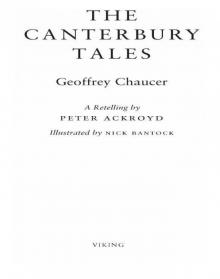 The Canterbury Tales
The Canterbury Tales J. M. W. Turner
J. M. W. Turner Chatterton
Chatterton The Canterbury Tales – A Retelling
The Canterbury Tales – A Retelling Alfred Hitchcock
Alfred Hitchcock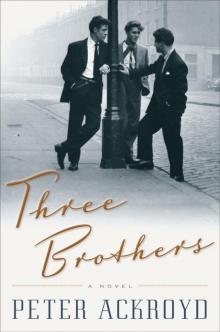 Three Brothers
Three Brothers Wilkie Collins
Wilkie Collins Venice
Venice Poe
Poe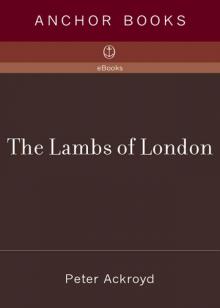 The Lambs of London
The Lambs of London London
London Queer City
Queer City Revolution, a History of England, Volume 4
Revolution, a History of England, Volume 4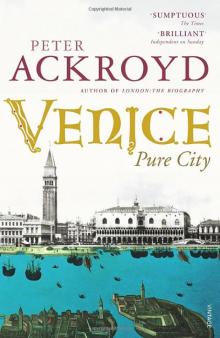 Venice: Pure City
Venice: Pure City Foundation
Foundation Thames
Thames The Plato Papers
The Plato Papers The house of Doctor Dee
The house of Doctor Dee Rebellion: The History of England from James I to the Glorious Revolution
Rebellion: The History of England from James I to the Glorious Revolution Albion: The Origins of the English Imagination
Albion: The Origins of the English Imagination The Fall of Troy
The Fall of Troy The Death of King Arthur
The Death of King Arthur The Trial of Elizabeth Cree
The Trial of Elizabeth Cree London: The Biography
London: The Biography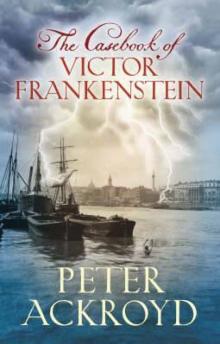 The Casebook of Victor Frankenstein
The Casebook of Victor Frankenstein Hawksmoor
Hawksmoor Charlie Chaplin
Charlie Chaplin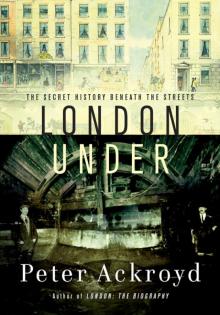 London Under
London Under